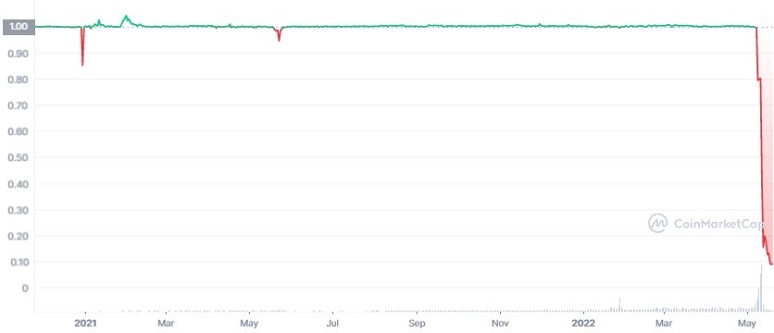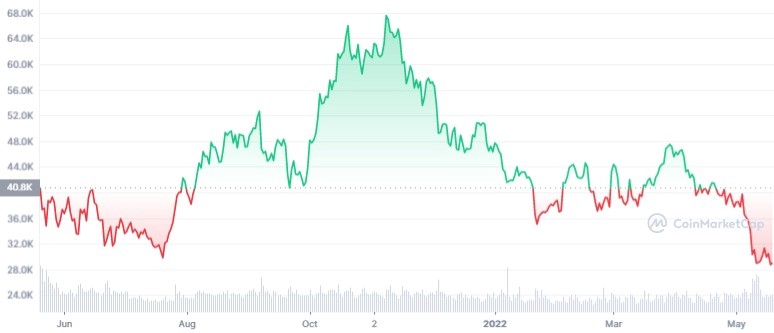On the weekend of the 7th/8th May 2022, the sky fell on the crypto market. A stablecoin called Terra started a freefall which precipitated a crash on the whole crypto market. Prior to the fall, Terra ranked in the top 10 crypto coins, with a market value of over US$18.7 billion and is now virtually worthless. The most popular cryptocurrency, Bitcoin, has dropped by a massive 62% from its all-time high recorded in November 2021. These falls are not unprecedented in the volatile crypto market, however, this crash is different from others and reveals a vulnerability in the ecosystem which serves as a warning to regulators.
Price chart of Terra (UST)

Source: Coinmarketcap
Price chart of Bitcoin

Source: Coinmarketcap
How does Terra work?
Terra, otherwise known as UST, is referred to as a stablecoin similar to Tether which is the best known of all stablecoins. This subset of the crypto market is designed to be virtually immune from volatility as it is backed by collateral of real value. For example, Tether is backed by US dollar denominated assets such as US government bonds and other ‘safe’ financial instruments.
Terra, one of the newer breeds of stablecoins, differs as its value is determined by a complex algorithm which depends on a sister coin called Luna. 'Terra' and 'Luna' take their names from the Latin words for earth and moon, with the relationship between the Terra blockchain and the Luna token supposedly representing the gravitational force between the two.
The value of Terra is meant to be pegged to the US dollar, however through either excess supply or demand, could theoretically trade slightly above or below the US dollar peg temporarily until it is re-balanced. It never traded outside a range of US$0.85 to US$1.05 prior to its collapse. The value of Terra is automatically rebalanced through the operation of its protocol by either the burning (decrease in supply) or minting (increase in supply) of its collateral coin, Luna. Envision the entire Terra ‘economy’ to consist of a Terra pool and a Luna pool, which attempt to maintain parity through a process of arbitrage.
So how did the crash happen?
Do Kwon is the South Korean developer and co-founder of Singapore based Terra (Terraform Labs) and network token Luna. His rise and fall within the crypto community was rather rapid even in fast developing industry. Terra and Luna peaked during a time when the entire cryptocurrency market was in decline. Their popularity was primarily due to a lending platform called Anchor.
Anchor promised Terra users a high annual percentage yield (APY) of 19.5% by investing the coin on their protocol. Think of the Anchor Protocol as a bank. An investor, (Bill) deposits $20,000 worth of Terra on the Anchor protocol. Anchor lends out the deposit to a borrower (John) who pays interest to Anchor. John needs to put down some of his own crypto collateral as security which also generates a yield. The yield from John’s collateral as well as the interest he pays Anchor, goes to pay the 19.5% interest to Bill. Crucially, the deposits and interest are denominated in Terra.
About 75% of Terra’s circulating supply was deposited in this way. As Anchor’s revenue began to dwindle, it decided to convert its interest rate from a fixed rate to a variable and reduce it from 19.5% to 4% p.a. Consequently, dismayed at the significant reduction in their return, investors started withdrawing their Terra coins at an accelerating rate. This sparked a spiraling sell down of Terra and Luna as the market lost confidence in the algorithm as it struggled to cope with the overwhelming market forces. This was like a run on a bank.
The market was spooked further by a massive sell down of Bitcoin by an investor known as the Luna Foundation Guard, an organisation set up Do Kwon. According to Coindesk, it is the second largest known holder of Bitcoin. The Foundation was established to support the stability of the Terra stablecoin. It did this by holding in reserve over US$3.1 billion worth of Bitcoin and other crypto assets to instill market confidence in Terra in the event that any major market anomaly caused a major price shift. However, this backstop ultimately backfired. The Foundation started selling Bitcoin to buy Terra in an attempt to support its price during its collapse. This caused a devaluation of Bitcoin and triggered a domino effect on the entire crypto market.
Confidence is everything
Confidence in the ecosystem in which crypto coins trade is essential. This is the same as the need for public confidence in any fiat currency to ensure its relative stability. According to Coindesk, there have been other bank runs on algorithmic stablecoins. In 2020, Do Kwon had co-led Basis Cash, another failed algorithmic stablecoin project that crashed due to regulatory concerns. Kwon had ignored repeated warnings by other market experts against the dangers of an algorithmic stablecoin design. In 2021 Senior Economist Francis Coppola warned that:
“self-correction mechanisms that rely on financial incentives do not work when panicking humans are stampeding for the exit”.
Algorithmic stablecoins are not foolproof as their rebalancing mechanism relies on variables that can’t be controlled such as investor demand, arbitrage traders who trade rationally, and reliable price information. In Terra’s case it seems likely that an unusually large withdrawal knocked the entire system out of balance.
Despite Terra’s failure, Do Kwon is adamant the Terra blockchain and Luna coin can be revived through an on-chain governance proposal to hard fork the existing network. At the time of this writing, 92% of the Terra community have voted against the proposed changes by Kwon. Market experts believe a lack of trust in Terra and Kwon could be the reason.
Founder of Defi security firm HashEx and market commentator Dimitry Mishunin summed up the negative sentiment by claiming:
“The primary challenge the Terra community has against a new fork as proposed by Do Kwon is trust. Should the team choose to proceed with the new fork, there will be a need to increase trust.”
Regulators cannot stand and watch
These crypto market failures reinforce the need for a comprehensive regulatory framework. This latest washout is leaving mums and dads holding the can. Many were enticed by the promise of the stability and security that stablecoins offered. Close scrutiny is needed of any product claiming to be ‘safe’. At the moment there is little to no protection for these investors, as there is no regulatory framework in place for the creation of stablecoins, how they should be defined and the mechanisms under which they should operate. Without a clear set of rules, unscrupulous and unscrutinised cowboys will continue to design flawed crypto products at the expense of a naïve public.
Dr. Paul Mazzola is a Lecturer in banking and finance in the Faculty of Business at the University of Wollongong, and Mitchell Goroch is a Cryptocurrency Trader and Researcher at the University of Wollongong.
This article is general information and does not consider the circumstances of any person.